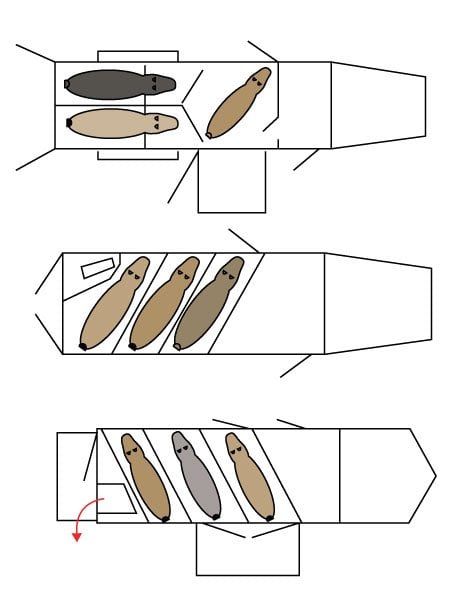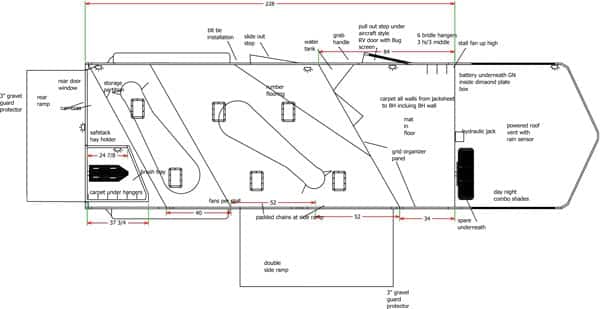Is a 2+1 Horse Trailer the Best Option for You?
The 2+1 horse trailer design has steadily been gaining popularity over the last several years. In comparison, the Safetack Reverse 3 Horse Trailer from Double D Trailers has many of the same great features as a 2+1 horse trailer, with several note-worthy improvements. So who wins the battle of the trailers? Let’s take a closer look at the features on a standard 2+1 horse trailer vs. the 3 horse SafeTack Reverse model and see how they stack up against each other in a head-to-head comparison.
Why 2+1 Horse Trailer Interiors Can Be Dangerous
2+1 horse trailers have two horses loaded straight into the rear of the trailer with one horse standing freely in a forward ‘box’ stall. The rear horses are reliant on chest bars to secure their position and provide a balancing point in case the driver needs to brake suddenly. The forward horse is left without any stabilizing structures.
The dangers here are two-fold.
Brad explained, “Anytime there is a chain or bar, there’s a risk of a horse getting a leg over. The greatest risk seems to always be with the chest bar.” If those two rear horses didn’t have their chest bars, they would slam their face into the box stall doors. On the other hand, the chest bars create the hazard of a horse rearing up and hooking a leg over top.
The second danger is to the front horse. He is left without any security or support in the case of a sudden stop. “The ‘+1’ seems to be an after-thought,” Brad shared. “While I can build a 2+1 horse trailer, I am not a fan of the dangers associated with chest bars or the downfall of not having a front horse secured in a smaller stall.”
With the SafeTack Reverse 3 Horse Trailer, these two problems are solved by providing each of the three horses with a secure stall in which to stand. During transit in the SafeTack Reverse, your horse can brace against the safety partitions on the sides of his body. In the event of a sudden stop, the horse is pushing against a full partition instead of a single bar. Plus, there is no danger of them hooking a leg over top of this barrier.
The SafeTack Reverse 3 Horse Trailer has both rear and side ramps to allow for easy access to all three of your horses. This is especially important in an emergency situation. In contrast to a conventional three horse slant load design, you don’t need to off-load both rear horses before you could access the horse in the front most stall.
Top: The 2+1 horse trailer design with two access doors and a cramped front box stall.
Second: A conventional 3 horse slant trailer with a stationary rear tack and only one access door.
Bottom: A SafeTack Reverse 3 horse trailer with two access doors, a moveable SafeTack compartment, and a shorter overall trailer length to allow for more maneuverability while driving. This trailer can be used for both forward and rear facing horses.
Length and Drivability
Your number one consideration when purchasing any horse trailer model should always be for the safety of your horses and family while traveling on the roadways. The length and maneuverability of your trailer can make a huge impact.
A typical 2+1 horse trailer has a floor length of 22 feet with a total length that can exceed 29 feet including the gooseneck. Brad Heath, owner of Double D Trailers explained, “This can often result in a long trailer that is hard to maneuver while driving.”
In contrast, the SafeTack Reverse 3 Horse Trailer has a floor length only around 18 feet with 25 '6 " total length. This leaves you with a trailer that is more manageable while parking on show grounds, navigating windy farm lanes, and maneuvering through roads on the way to your destination.
Forward or Rear Facing?
There is a strong case to suggest that horses do better with rear-facing designs. A 2+1 horse trailer is not configured to handle rear-facing horses. In contrast, the SafeTack Reverse design configuration allows you the flexibility to choose the direction of travel that works best for your particular horses.
Loading on the SafeTack Reverse 3 Horse Trailer is easy. You can choose to load from the side ramp and lead the horses back into the rear stall. This would result in a rear facing orientation for travel. To offload, you simply open the back ramp and lead them straight off.
Or, if your horses prefer, you could close that front side ramp and instead load from the back resulting in a front-facing orientation. Then, simply open the side ramp and again, lead them straight off. This ‘walk-thru’ design is much safer for the handler.
This video shows what the walk-thru design on the SafeTack Reverse looks like in action:
Do Big Horses Fit in 2+1 Horse Trailers?
Another common complaint for the typical 2+1 horse trailer configuration is the size of the front box stall. One reviewer on a popular horse forum explained that closing the door dividers between the back horses and the front stall results in a ‘very small’ front stall. To enlarge that area, she opted to remove the entire interior partition leaving the rear horses full head access to the front horse. If the horses are not friendly with each other, this could result in some serious biting and kicking during travel.
The specific size of this box stall depends on the manufacturer, but remember, any size added here will simply add onto the overall length of your trailer affecting its drivability.
Many people are wary of conventional slant load horse trailers because they worry that their warmbloods and other larger breeds won’t fit. That is why we want to emphasize that the stall sizes on the SafeTack Reverse 3 Horse trailer can be custom made to fit your horse sizes.
Brad explained, “All trailers are 100% custom built to order, so the stalls are designed to ‘fit the horse.’” If you have horses that are 16.2, 17+, and 15.3 hands, the stalls could be individually designed to fit each of the animals. “Alternatively, we could easily build all three stalls to fit 17+ horses if needed, depending on the client’s needs.”
Box Stalls and Storage
An attractive feature on both of these trailers is the ability to use the forward ‘box’ stall for grooming, tacking up, or just letting your horse hang out at the show. With the SafeTack 3 Horse Reverse trailer, the front partition can easily be swung over so you can use the front two stalls to create this enclosure. The padded chains can then be connected to form a barrier for your horse.
Horses come with a lot of gear so it is important to consider how and where these supplies will be stored on your trailer. Most 2+1 horse trailer designs have a living quarters area in the front to serve as both your tack storage and dressing room areas.
In contrast, the SafeTack Reverse 3 Horse trailer has two separate compartments. The SafeTack storage area in the rear of the trailer provides an enclosed compartment where you can hang your saddles, bridles, pads, and grooming supplies. Since the compartment is lockable, you won’t need to worry about the security of your expensive gear throughout the show day.
This entire storage compartment swings out like a second rear door so it is never in the way while loading and unloading. It has been expertly balanced on its hinges so you can easily swing it where you’d like.
With the tack out of the way, the front dressing room on the SafeTack Reverse 3 Horse trailer can be used as a completely ‘human’ area. Use it however you want and don’t worry about tripping over tack and gear!
How is the SafeTack Reverse 3 Horse Trailer Different from a Conventional Slant Load Horse Trailer?
The main advantages of a SafeTack Reverse 3 horse over a conventional 3 horse slant load trailer are in its safety and convenience features. First, you can access each horse independently using either the rear or side doors with ramps. This is a huge safety advantage since conventional 3 horse slant trailers require you to off-load both rear horses before accessing the forward horse. Plus, the side ramp allows you to load horses in either a forward or reverse facing direction.
Next, the rear tack compartment on the SafeTack trailer swings out of the way for loading and unloading - avoiding the common problem of a ‘narrow’ door in the rear or the trailer. Horses are naturally claustrophobic animals and this tiny hole is the last thing they want.
Finally, most conventional slant load designs are limited in their ability to fit 17+ hand horses. With the SafeTack Reverse 3 horse trailer, the stalls can be custom designed to fit your horses no matter their sizes.
To sum it up, Brad explained, “The patented Double D Trailers SafeTack Reverse solves the problems associated with ‘conventional’ slants, and has all the benefits of a 2+1 horse trailer without the added drawbacks of a 2+1.”
If you’d like to learn more about our horse trailer models, feel free to reach out to Brad.
Read more about the pros and cons of the 2+1 horse trailer design.




